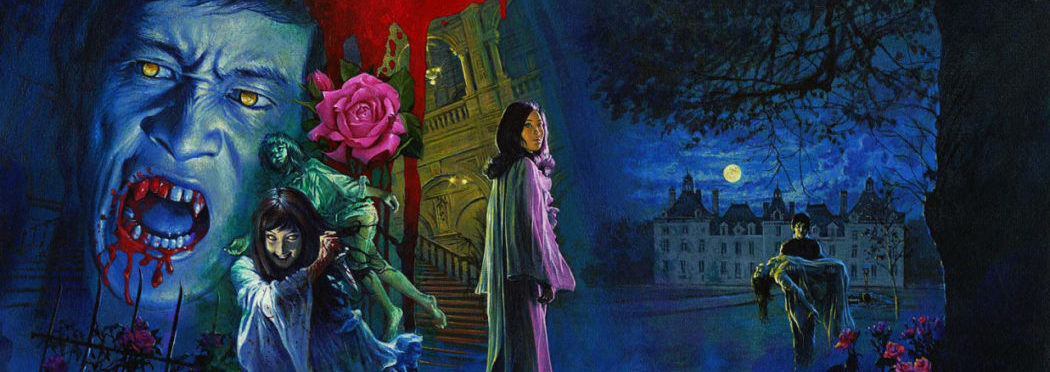
 There aren’t a lot of extras on the new release of Toho Studios’ trio of vampire movies, collectively known as The Bloodthirsty Trilogy, but given Arrow Video’s excellent high-definition presentation, there doesn’t really need to be; especially with three films to work one’s way through: The Vampire Doll, Lake of Dracula, and Evil of Dracula.
There aren’t a lot of extras on the new release of Toho Studios’ trio of vampire movies, collectively known as The Bloodthirsty Trilogy, but given Arrow Video’s excellent high-definition presentation, there doesn’t really need to be; especially with three films to work one’s way through: The Vampire Doll, Lake of Dracula, and Evil of Dracula.
However, the one extra aside from stills and trailers is “Kim Newman on The Bloodthirsty Trilogy,” a video appraisal by the critic and writer. It’s essentially just Newman talking about vampire pictures and how Japanese producers adapted them for their audience, but it’s really a deft and clever analysis of Japanese horror and vampire movies, as well as how the ’70s fetish for fang films brought the two together.
One of the more salient points Newman makes is that these three films are much like Mario Bava’s Black Sunday, which Tim Burton reportedly said he’d seen almost a dozen times, but to which he couldn’t ever remember the plot. These films are, as Newman states, movies which blend together in the mind and start to meld together, existing almost as if in a dream from which one has just woken.
The Bloodthirsty Trilogy is, as a whole, something which I watched over a period of three days, and despite having done so recently, it still requires a look at Google to get the specifics down as to which is which. These were all films which I watched with a great deal of attention paid to each, too. There’s no dubbing, so any attempt to throw one of these on while making dinner or working on some writing project means looking away for 10 seconds can result in missing a major plot point by not reading the subtitles.
They are, as a whole, certainly unique, although of a type. While definitely based in Japanese culture — the interactions between all the characters not trying to suck blood are resolutely polite and deferential — they owe more to the Hammer Dracula films and Roger Corman’s Poe films in their looks and settings. The first, The Vampire Doll, even goes so far as to make the late father of a dead girl having been a foreign diplomat, so that even the house is in Western style.

Plus, you even have vampires in capes and white scarves. It’s almost as if these directors were trying to recreate something they’d seen, rather than make something of their own. Still, the glowing eyes of the vampires and the look of the female vampires in all three films, with their straight black hair and whitened faces, certainly look to Japanese ghost folklore.

I watched these three movies in reverse order, and can confirm that there are certain advantages to doing so. Evil of Dracula is certainly not the best of The Bloodthirsty Trilogy, but I would argue that it’s the most entertaining, at least until there’s a 15-minute drag toward the end. For the most part, though, it’s faster-paced, opting to get right to the vampirism and blood and scantily-clad young ladies. It definitely prefers prurience over pacing, and it’s definitely more fun because of it.
Lake of Dracula is akin to a Jean Rollin film, loaded with lots of shots of water and mysterious young women, but it’s resolutely the least interesting of the three. The plot’s a little too much like a romantic love triangle with hints of the undead, and there’s not enough strange mist and gauzy-filtered shots to really pull it off convincingly.
The Vampire Doll is, arguably, the best of the three films: the acting is superior, and the plot’s an interesting mix of missing person and vampire film, with just a hint of revenging spirit thrown in for flavor. It also makes the most of moving around, whereas the other two films feel slightly claustrophobic, really not moving much from one main setting, and feeling as if everything’s shot within 20 feet of the the front door.
Certainly, The Bloodthirsty Trilogy is worth viewing: all three films look amazing, and each one is only 90 minutes or so, meaning they don’t make for a serious time investment. None of them will necessarily stick in your mind in terms of shock or significant imagery, but the experience of cultural melding, and the East pulling from the West — as opposed to the usual cultural whitewashing which happens during the far more frequent reverse — makes for a very singular trilogy of movies.
The Bloodthirsty Trilogy is available on Blu-ray from Arrow Video and can be purchased through Diabolik.




